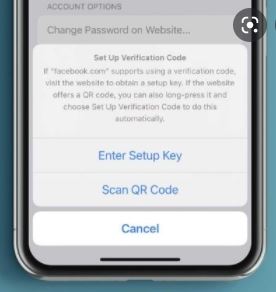Apple’s Password Authenticator works a bit more smoothly than rivals. It lets you set up the verification code required for additional sign-in security via the setup key or by scanning the QR code. Once the setup is complete, the password authenticator automatically generates a 6-digit verification code every 30 seconds, which you can use to authenticate your password.

You can either copy and paste the verification code manually or let Apple autofill the code when you log into a website or app. In a nutshell, the verification process will feel more intuitive, secure, and faster. Apple eliminates the need to switch between apps to get the 2FA code on your iPhone and iPhone. Therefore, we suggest you set it up for all of your apps as there is no additional hassle. Instead, it will only help safeguard your data and personal information
Set Up Built-in Password Authenticator on iPhone and iPad
As have mentioned above, you first need to set up the verification code for the app or website you want to safeguard with two-factor authentication. To do that, just follow the steps below;
- Go to the Settings app on your iPhone and iPad.
- scroll down and tap on Passwords.
- you will need to authenticate using Face ID/ Touch ID or your passcode to proceed
- On the next page, you will see a list of all the websites and apps whose passwords you have saved in the iCloud Keychain. Now, make sure that the website for which you want to set up the verification code is saved here
- If a website or app is not on the list, tap the “+” at the top right corner of the screen, and enter the website address, your username, and password to save it. Make sure to tap Done at the top right to finish.
- tap on the name of the app or website for which you want to use the built-in password authenticator on your iPhone or iPad. Then, tap the “Set Up Verification Code…” option
- Next, there are two ways to set up the verification code on your iPhone or iPad.
- Enter Setup Key: If the website supports using a verification code, head over to the website to get the setup key and either it here.
- Scan QR Code: If the website provides a QR code, you can long-press the QR code and select Set Up Verification Code to get it done automatically.

Set Up Verification Code for Facebook on iPhone and iPad
- Open the Facebook app and tap on the menu button (three horizontal lines) on the bottom navigation bar. Then, move to Settings & Privacy -> Settings -> Security and Login.
- Now, tap “Use Two-Factor Authentication” and make sure the Authentication App option is selected. After that, tap the blue “Continue” button.
- you have three different options to choose from while setting up the 2FA verification codes. You can choose from the following
- Set up on the same device: Choose this option to set up the verification code for Facebook using the built-in password authenticator on your iPhone or iPad.
- Scan QR Code: If you have opened Facebook in Safari, long-press the QR code and choose the Open in “Settings” option.
- Copy the code: Lastly, you also have the option to copy a unique code and enter it into the Settings.
How to Delete Password Authenticator Setting for an App in iOS 15
- Navigate to Settings -> Passwords. After Face ID/ Touch ID authentication, tap on the app’s name you want to delete the verification code for.
- Next, tap on “Edit” at the top right corner.
- tap the “-” (minus) button under the verification code section to reveal the “Delete” button
- Finally, Tap the “Delete” button. From the pop-up message that appears, select the “Delete Verification Code” option.
Conclusion
Considering how critical it is to have an extra layer of safeguard against hacking these days, most websites and apps support two-factor authentication. With 2FA enabled for your account, you must verify your identity with an additional code to sign in. What makes 2FA so essential is the ability to shield your account even if your passwords are leaked. Up until iOS 14, iPhone users had to rely on third-party authenticator apps like Google Authenticator and Authy to generate 2FA verification codes.